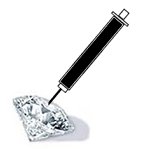
August Editorial
Doping Diamonds

August Editorial
Doping Diamonds
|
|
Doping is a term often used in the field of semiconductors. It refers to the process by which impurities are introduced into a pure semiconductor substrate, most commonly silicon, in order to change its electrical properties. For most of us semiconductors are a rather exotic subject, so before going any further a quick introduction is in order: "A semiconductor is a material that is an insulator at very low temperatures, but which has a sizable electrical conductivity at room temperature." OK, now that we have done with the basic definition, let's see what happens when a semiconductor is doped. In simple terms, impurities, often called dopants, alter the electrical properties of the semiconductor. So adding smaller or larger amounts of dopants can change the electrical property of the substance in a very controlled way. Depending on the dopant - extra electrons or holes will be added to the semiconductor. If the foreign material introduced to the semiconductor gives off electrons to the conduction band it is referred to as a donor and a semiconductor with extra electrons is called an n-type semiconductor. Alternatively, if the dopant excepts electrons from the semiconductor (gives off holes) it is called a recipient and the semiconductor a p-type semiconductor. A heavily doped semiconductor can increase its conductivity by a factor greater than a billion. In modern integrated circuits, for instance, heavily-doped polycrystalline silicon is often used as a replacement for metal. Well, so where in all that does the diamond fit? We all know that diamond, like many minerals, is rather bad at conducting electricity - but is it? It appears that in the last couple of years diamonds have been tipped as semiconductors of the future. It is now possible to obtain synthetic thin-film diamond and in a recent Nature article P. Strobel et al. (Nature, 2004, vol 430, pp 439) discussed a new method of doping diamonds by evaporating C60 molecules onto the hydrogen-terminated diamond surface. This process introduces a subsurface accumulation of holes which significantly increases the diamond's conductivity. The authors predict that this simple process of re-melting carbon 60 onto the diamond surface will be sufficient to turn a diamond into a good semiconductor without the necessity of introducing additional dopants. So will Silicon Valley be replaced with Diamond Valley? Watch those diamonds ... . |
| _______________________________ | ||||
| Home | | | Shopping | | | Database |
© Biscuit Software 2004-2015
All rights reserved